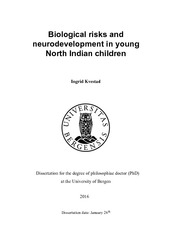| dc.contributor.author | Kvestad, Ingrid | |
| dc.date.accessioned | 2016-03-15T10:21:16Z | |
| dc.date.available | 2016-03-15T10:21:16Z | |
| dc.date.issued | 2016-01-26 | |
| dc.identifier.isbn | 978-82-308-3409-1 | |
| dc.identifier.uri | https://hdl.handle.net/1956/11640 | |
| dc.description.abstract | Background. Children growing up in poverty face multiple biological and psychosocial risks, some of which are primarily found in low to middle income countries. Unfavourable biological circumstances, such as inadequate nutrition and childhood illnesses put children at risk for compromised development. Early child development is a precursor for later cognitive functioning and may have lasting consequences for academic achievement and lifelong quality of life. There is a need to identify modifiable risk factors for poor development in order to break the vicious cycle of poverty and poor development. Objectives. The objectives of the current thesis are threefold. First, to examine the effect of two recommended daily allowances of vitamin B12 and/or folic acid for six months on neurodevelopment. Second, to identify other relevant risk factors for poor neurodevelopment in young North Indian children; and, finally, to assess the feasibility of the screening tool Ages and Stages Questionnaire 3rd ed. (ASQ-3) administered by field supervisors to collect reliable data on neurodevelopment in this North Indian field setting. Methods. In a randomized double blind trial, children six to 30 months were given vitamin B12 and/or folic acid or placebo daily for six months. At the end of the study, we measured neurodevelopment in 422 children by ASQ-3 administered directly with the child. During the six months study period, we collected data on childhood illnesses bi-weekly. Information regarding socioeconomic status was collected at baseline, and information regarding stimulation and learning opportunities was collected at end study. Applying linear and logistic regression models, we measured the effect of vitamin B12 and/or folic acid on neurodevelopment, and identified other predictors of developmental status. We also assessed the psychometric properties of the ASQ-3 in the current setting. Results. Compared to placebo, children who received both vitamin B12 and folic acid had 0.45 (95% CI 0.19, 0.73) and 0.28 (95% CI 0.02, 0.54) higher SD-units in the domains of gross motor and problem solving functioning, respectively. The effect was highest in selected subgroups consisting of stunted children, those with evidenceof folate and vitamin B12 deficiency and in those who were younger than 24 months at the end of the study. With the exception of a significant improvement in gross motor scores by vitamin B12 alone, supplementation of either vitamin alone had no effect on any of the outcomes measures. In the multiple regression models, we were able to explain 30.6% of the variation in the total ASQ-3 score. Height for age and weight for height z-scores were positively associated with the total ASQ-3 score, while the number of days with diarrhea was negatively correlated. Variables defined as stimulation and learning opportunities explained most of the variation (25.9%). Our results also indicate that it is possible to collect reliable data on neurodevelopment in this field setting using ASQ-3. Conclusion. Vitamin B12 and folate deficiency, stunting and prolonged diarrhea illness may be important modifiable biological risks adverse neurodevelopment in young children in the current setting. Adequate stimulation and responsive care are crucial for healthy development. Interventions targeting young children growing up in poverty in LMIC should integrate various modifiable risk factors including nutrition, hygiene and early child stimulation to maximize developmental potential in children. | en_US |
| dc.language.iso | eng | eng |
| dc.publisher | The University of Bergen | eng |
| dc.relation.haspart | Paper I. Kvestad, I., Taneja, S., Kumar, T., Bhandari, N., Strand, T. A., & Hysing, M. (2013). The assessment of developmental status using the Ages and Stages questionnaire-3 in nutritional research in north Indian young children. Nutrition journal, 12(1), 50. The article is available at: <a href="http://hdl.handle.net/1956/8030" target="blank">http://hdl.handle.net/1956/8030</a> | eng |
| dc.relation.haspart | Paper II. Kvestad, I., Taneja, S., Kumar, T., Hysing, M., Refsum, H., Yajnik, C.S., Bhandari, N., & Strand, T.A. (2015). Vitamin B12 and Folic Acid Improve Gross Motor and Problem-Solving Skills in Young North Indian Children: A Randomized Placebo-Controlled Trial. PLoS ONE, 10(6). The article is available at: <a href="http://hdl.handle.net/1956/10882" target="blank">http://hdl.handle.net/1956/10882</a> | eng |
| dc.relation.haspart | Paper III. Kvestad, I., Taneja, S., Hysing, M., Kumar, T., Bhandari, N., & Strand, T. A. (2015). Diarrhea, stimulation and growth predict neurodevelopment in young north Indian children. PloS ONE, 10(3). The article is available at: <a href="http://hdl.handle.net/1956/11731" target="blank">http://hdl.handle.net/1956/11731</a> | eng |
| dc.title | Biological Risks and Neurodevelopment in Young North Indian Children | eng |
| dc.type | Doctoral thesis | |
| dc.rights.holder | Copyright the author. All rights reserved. | eng |
| dc.subject.nsi | VDP::Medisinske Fag: 700 | |
